Land
What is Land?
Land is the solid surface of the Earth. It covers only about 30% of the Earth’s surface, and not all land is habitable.
Land and Resources
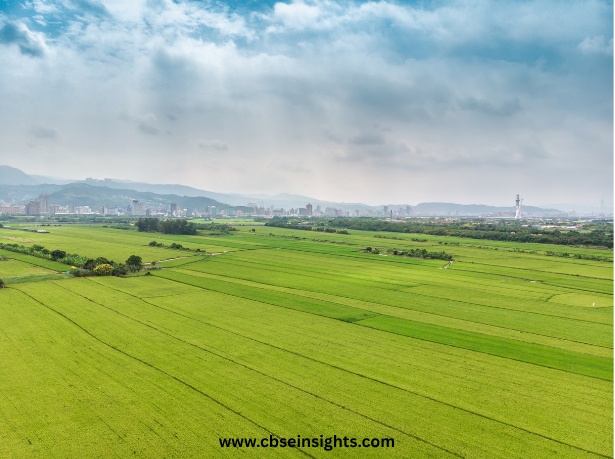
Use of Land
Land is used for:
- Agriculture – farming and livestock. Agriculture is the practice of growing crops and rearing animals for food, fiber, medicinal plants, and other products used to sustain and enhance human life.
- Forestry – wood and forest products. Forestry is the planting, managing, and caring of trees and forests to use them for wood, shelter, oxygen, and protecting nature.
- Mining – extraction of minerals and fuels. Mining is the process of digging out minerals and other useful substances from the Earth’s surface or underground. Mining means taking out valuable minerals like coal, iron, gold, or salt from the Earth.
- Building houses, industries, and roads
- Recreation – parks, stadiums. Recreation refers to activities that people do for enjoyment, relaxation, and fun during their free time. Recreation means doing fun activities like playing, travelling, hiking, or relaxing in parks to refresh the body and mind.
LAND USE PATTERN
Land use depends on:
- Topography – shape of the land. Topography means the shape, surface features, and elevation of the land — like plains, mountains, valleys, and plateaus.
- Soil type – Soil type means the kind of soil found in a particular area – based on its texture, fertility, color, and minerals. Different soils support different uses of land.
- Climate – Climate refers to the average weather conditions (like temperature, rainfall, humidity, wind) of a place over a long period of time.
- Population and human needs – Population refers to the number of people living in a particular area, and human needs are the basic requirements like food, shelter, water, jobs, and transport. As population grows, people need more land for housing, farming, roads, schools, hospitals, industries, etc. So, land is used based on how many people live in an area and what they require.
- Technological capability – Technological capability means the use of modern tools, machines, methods, and knowledge to make better use of land and natural resources. With advanced technology, people can use land more efficiently, even in areas that were difficult to use earlier — like deserts, mountains, or underwater areas.
PROBLEMS OF LAND DEGRADATION
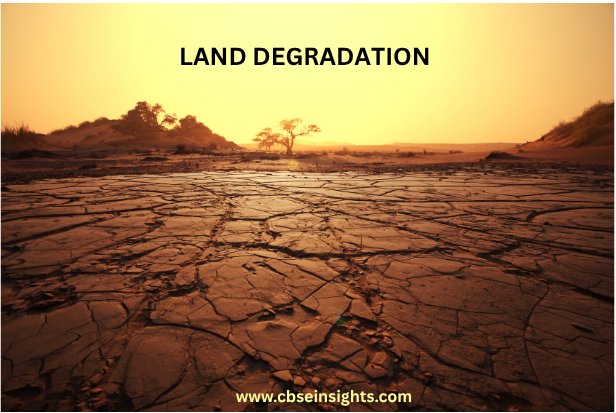
Land degradation means the land becomes less useful for farming, building, or supporting life because of overuse or damage.
- Deforestation (cutting too many trees) Deforestation is the large-scale removal of trees and forests, usually done to clear land for farming, building houses, industries, roads, or for using the wood. Forests are cut down without proper planning, and the land is not replanted. This harms the environment and life around us.
- Overgrazing by animals (too many animals eating grass) Overgrazing happens when too many animals feed on the same piece of land for a long time, and the grass and plants do not get time to grow back. This causes the land to become bare, dry, and unproductive.
- Over-irrigation (leads to waterlogging and salinity) Over-irrigation means supplying too much water to crops or land, more than what is needed by the plants. It often happens when farmers use water continuously without checking the soil’s condition or the plant’s needs.
- Use of chemicals (harms soil fertility) It refers to the use of chemical fertilizers, pesticides, and insecticides in farming to increase crop production and protect plants from pests. These chemicals are made in factories and are used to improve growth quickly – but if overused or misused, they can damage the soil and environment.
- Mining and quarrying (removes topsoil and damages land) Mining is the process of extracting minerals and valuable materials like coal, gold, iron, and copper from deep under the Earth’s surface. And Quarrying is the process of removing stones, sand, or gravel from shallow, open pits near the surface of the Earth.
- Soil erosion (removal of topsoil by wind or water) Soil erosion is the removal of the top fertile layer of soil by natural forces like wind, water, and human activities. This topsoil is rich in nutrients and is very important for growing crops. Once it is lost, the land becomes less fertile.
CONSERVATION OF LAND RESOURCES
Conservation of land resources means protecting, managing, and wisely using land so that it remains fertile and useful for future generations. It involves preventing land degradation, soil erosion, and overuse, and promoting sustainable farming and development.
Why is Land Conservation Important?
- Land is used for farming, housing, industries, roads, and forests.
- Only 29% of Earth’s surface is land — and much of it is not suitable for human use.
- Overuse and misuse of land leads to problems like:
- Deforestation
- Soil erosion
- Desertification
- Loss of biodiversity
- Afforestation (Planting trees to prevent soil erosion and restore greenery) Afforestation means planting trees in an area where there were no previous forests, or where forests were destroyed. It helps restore greenery, protect the soil, and balance the environment.
- Terrace farming (reducing soil erosion in hilly areas) is a method of farming where steps or terraces are built on hill slopes to grow crops. Each step slows down the flow of water, reducing soil erosion and helping water stay in the soil.
- Regulated grazing (Controlling how animals graze to protect grasslands) means controlling the number of animals and rotating grazing areas so that grasslands are not overused and get time to regrow.
- Avoiding chemical overuse in farming (Using natural fertilizers and eco-friendly farming techniques) 3
- means using chemical fertilizers, pesticides, and insecticides in limited and correct amounts, or using natural alternatives to protect the soil, crops, and environment.
- Waste land reclamation
- Land use planning
SOIL RESOURCES
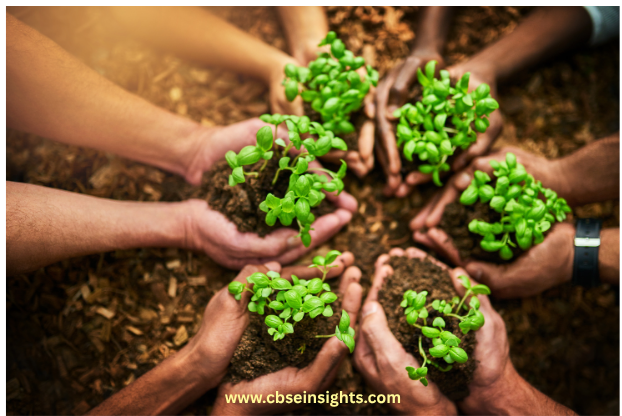
What is Soil?
Soil is the top layer of the Earth’s crust formed from weathered rock and organic material. It is essential for agriculture and supports plant growth.
Soil Formation
- Takes thousands of years
- Formed by:
- Weathering of rocks (breaking down by wind, water, or temperature)
- Decomposition of plants and animals
Factors Affecting Soil Formation
- Parent Rock (or Parent Material)
- It is the original rock from which the soil is formed.
- It determines the texture, mineral content, and color of the soil.
- Example: Soil formed from granite is sandy, while soil from basalt is clayey and rich in iron.
- Climate
- Climate is one of the most important factors.
- Rainfall, temperature, and wind affect the weathering of rocks.
- High rainfall leads to more erosion and leaching, while extreme temperatures speed up breaking down of rocks.
- Relief (or Topography)
- It refers to the shape and height of land.
- On slopes, soil may be thin due to erosion.
- In plains or valleys, thick and fertile soil is found as materials get deposited.
- Water drainage and sunlight exposure also depend on relief.
- Time
- Soil formation is a very slow process.
- It takes hundreds to thousands of years for a small layer of soil to form.
- The older the soil, the more developed and fertile it becomes, especially if not disturbed.
- Natural Vegetation and Organisms
- Plants, animals, bacteria, and fungi add organic matter (humus) to the soil.
- Roots break rocks and help mix the soil.
- Earthworms and insects aerate the soil and make it richer.
- Human Activities (sometimes considered an additional factor)
- Though not natural, human actions like deforestation, farming, construction, and mining also affect soil formation and quality.
Types of Soil in India
Soil Type | Description | Found in |
Alluvial Soil | Fertile, good for crops | Northern plains (Ganga, Brahmaputra) |
Black Soil | Rich in clay and humus, holds moisture | Deccan Plateau (Maharashtra, MP) |
Red Soil | Less fertile, rich in iron | Tamil Nadu, Karnataka |
Laterite Soil | Rich in iron and aluminum, poor fertility | Western Ghats, NE India |
Mountain Soil | Found in hilly terrain | Himalayan region |
Desert Soil | Sandy, low fertility | Rajasthan, Gujarat |
SOIL EROSION AND CONSERVATION
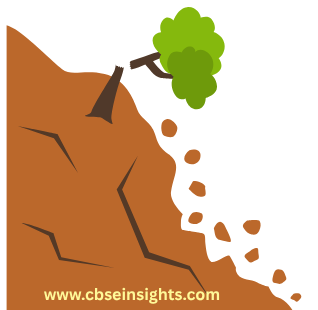
Soil erosion is the removal of topsoil due to wind, water, and human activity.
Conservation Methods:
- Afforestation
- Planting more trees to hold the soil together.
- Tree roots prevent soil erosion by wind and water.
- Also improves soil moisture and fertility.
- Terrace Farming
- Commonly used in hilly areas.
- Steps or terraces are built on slopes to slow down the flow of water.
- Reduces soil erosion and helps in water conservation.
- Contour Ploughing
- Ploughing is done across the slope, along the natural curves (contours) of the land.
- Prevents rainwater from washing away the soil.
- Conserves both soil and water.
- Regulated Grazing
- Allows limited number of animals to graze on land.
- Prevents overgrazing, which destroys grass and exposes soil to erosion.
- Helps grass to regrow and maintain soil cover.
- Shelter Belts
- Planting rows of trees or shrubs (like belts) along fields.
- Acts as a barrier to strong winds.
- Protects soil from wind erosion, especially in dry and sandy areas.
- Crop Rotation
- Growing different crops in the same field in a planned sequence.
- Prevents depletion of specific nutrients in soil.
- Some crops (like legumes) even improve soil fertility.
- Avoiding Overuse of Chemicals
- Excess use of fertilizers and pesticides damages soil quality.
- Using natural manures and compost keeps the soil rich and healthy.
- Use of Organic Farming
- Involves farming without harmful chemicals.
- Uses bio-fertilizers, cow dung, compost, and green manure.
- Maintains long-term soil fertility.
- Building Check Dams
- Small dams are built across streams or slopes to slow water flow.
- Prevents water from carrying soil away.
- Also helps recharge groundwater.
WATER RESOURCES
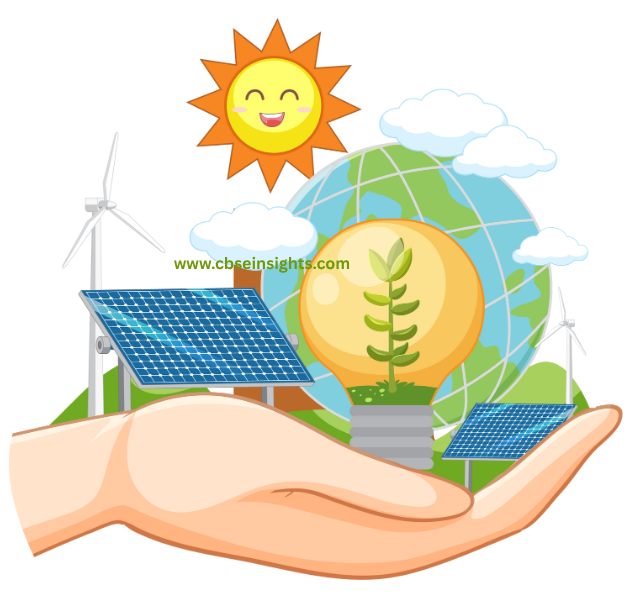
🔸 Importance of Water
- Covers 71% of Earth’s surface
- Used for:
- Essential for Drinking and Daily Needs
- Water is needed for drinking, cooking, bathing, and cleaning.
- A person cannot survive without water for more than a few days.
- Safe and clean water is important for good health.
- Required for Agriculture
- Water is used for irrigation in farming.
- Crops like rice, sugarcane, and wheat need a large amount of water.
- Without water, food production would stop.
- Used in Industries
- Many industries use water for cooling machines, cleaning, and as a raw material (e.g., in paper, textile, food industries).
- Industrial growth depends on the availability of water.
- Helps in Electricity Generation
- Water is used to produce hydroelectric power (electricity from flowing water).
- This is a clean and renewable source of energy.
- Supports Aquatic Life
- Rivers, lakes, and oceans are home to fish and other aquatic animals.
- Water bodies provide oxygen, food, and habitat to these organisms.
- Transportation and Navigation
- Rivers and seas are used as waterways for transporting goods and people.
- Water transport is cheaper and eco-friendly.
- Recreation and Tourism
- Lakes, rivers, and beaches are used for boating, fishing, swimming, and tourism.
- Tourism around water bodies creates jobs and income.
- Maintains the Water Cycle
- Water is an important part of the hydrological cycle (evaporation, condensation, rainfall).
- It helps maintain climate balance and supports plant growth.
Note: Freshwater Availability
Only 3% of water is freshwater.
- 2% is frozen in glaciers
- Only 1% is usable
Water Scarcity: Causes
Water scarcity is not caused by just one reason — it’s a result of overuse, pollution, poor planning, and natural imbalance. Everyone must work together to save and manage water wisely.
- Growing Population
- More people means more demand for water (for drinking, washing, cooking, etc.).
- It puts extra pressure on limited water sources.
- Urban areas often face severe shortages.
- Increased Agriculture
- Modern farming uses a lot of water for irrigation, especially for water-hungry crops like rice and sugarcane.
- Over-irrigation wastes water and lowers the water table.
- Traditional methods like flood irrigation also lead to water loss.
- Industrialization
- Industries need water for cleaning, cooling, and manufacturing.
- Many factories release wastewater into rivers, polluting freshwater.
- This makes less water available for drinking and farming.
- Uneven Distribution of Rainfall
- Some regions get too much rainfall, while others get very little.
- Drought-prone areas suffer from regular water shortages.
- Lack of proper water storage leads to rainwater being wasted.
- Deforestation
- Trees help maintain the water cycle and support groundwater recharge.
- Cutting down forests leads to less rainfall and more runoff, reducing underground water.
- Pollution of Water Bodies
- Lakes, rivers, and ponds are polluted by sewage, chemicals, plastics, and waste.
- Polluted water becomes unfit for use, reducing the availability of clean water.
- Mismanagement and Wastage of Water
- People often leave taps open or use more water than needed.
- Poor plumbing, leaking pipes, and wastage in cities lead to huge water loss.
- Lack of water-saving technologies makes the problem worse.
- Climate Change
- Global warming causes irregular rainfall, droughts, and melting of glaciers.
- Changes in weather patterns disturb the natural water supply.
Water Conservation Methods
Water Conservation means using water wisely and carefully to prevent its wastage and ensure its availability for future generations.
- Rainwater Harvesting
- Collecting and storing rainwater from rooftops, terraces, or open grounds.
- Stored water can be used for drinking, gardening, washing, or recharging groundwater.
- A very effective method, especially in places with low water supply.
- Reuse and Recycling of Water
- Using wastewater from kitchens or bathrooms (called grey water) for watering plants, cleaning vehicles, etc.
- Treating industrial and household wastewater to reuse in non-drinking purposes.
- Fixing Leaks and Drips
- Repairing leaking taps, pipes, and toilets saves a lot of water.
- A small drip can waste hundreds of liters per year if ignored.
- Use of Water-Saving Devices
- Using tools like low-flow taps, showerheads, and dual-flush toilets.
- These reduce the amount of water used in daily activities.
- Spreading Awareness
- Educating people (especially students and farmers) about the importance of saving water.
- Campaigns, posters, and workshops help spread the message.
- Drip Irrigation and Sprinklers
- Drip irrigation gives water drop by drop directly to the roots of plants.
- Saves a lot of water in farming.
- Sprinkler systems also reduce wastage and cover large farming areas efficiently.
- Growing Water-Efficient Crops
- Choosing crops that require less water, like millet and pulses.
- Reduces the pressure on irrigation in water-scarce regions.
- Building Check Dams and Tanks
- Small dams or bunds help store rainwater and slow down water flow.
- Helps in recharging groundwater and providing water in dry seasons.
- Protecting Forests and Wetlands
- Trees and forests help maintain the water cycle and increase groundwater recharge.
- Wetlands act like sponges, storing water during floods and releasing it slowly.
- Practicing Water-Smart Habits
- Simple actions like:
- Turning off the tap while brushing
- Using a bucket instead of a hose
- Watering plants early morning or evening
These small steps lead to big savings.
NATURAL VEGETATION
🔸 What is Natural Vegetation?
It refers to plants that grow naturally in an area without human help. It includes forests, grasslands, and shrubs.
🔸 Types of Natural Vegetation
Natural vegetation refers to plants and trees that grow naturally without human help. Different types of vegetation grow in different climates and regions.
- Forests – Dense growth of trees; high rainfall areas
- Grasslands – Dominated by grasses; moderate rainfall
- Shrubs – Thorny bushes; found in dry/desert regions
🔸 Importance of Vegetation
Vegetation refers to all types of plants and trees that grow naturally in an area. Vegetation plays a vital role in maintaining life on Earth.
- Provides Oxygen
- Plants and trees perform photosynthesis, during which they take in carbon dioxide and release oxygen.
- This oxygen is essential for all living beings to breathe and survive.
- Controls Climate and Temperature
- Vegetation helps to maintain temperature by absorbing sunlight and releasing moisture into the air.
- Forests act like the Earth’s air conditioners, helping to cool the planet and reduce the effects of global warming.
- Prevents Soil Erosion
- Roots of plants and trees hold the soil firmly.
- This prevents soil erosion by water or wind, especially during rains and storms.
- Maintains the Water Cycle
- Vegetation helps in evaporation and transpiration, which leads to cloud formation and rainfall.
- Forests and trees retain moisture in the atmosphere, keeping the water cycle balanced.
- Provides Habitat for Wildlife
- Forests and grasslands are homes for animals, birds, and insects.
- Different types of vegetation support different ecosystems and biodiversity.
- Source of Food and Medicine
- Plants provide fruits, vegetables, cereals, pulses, herbs, and spices.
- Many medicinal plants (like neem, tulsi, aloe vera) are used in traditional and modern medicines.
- Supplies Raw Materials
- Trees provide timber, wood, gum, resin, rubber, and fiber used in making furniture, paper, clothes, and more.
- Important for construction, crafts, and industries.
- Controls Air Pollution
- Trees absorb carbon dioxide, dust, and harmful gases like sulfur dioxide.
- They purify the air, making it healthier to breathe.
- Aesthetic and Recreational Value
- Parks, gardens, forests, and green landscapes provide peace, beauty, and relaxation.
- Important for mental health, tourism, and eco-tourism.
- Economic Importance
- Vegetation supports agriculture, forestry, and tourism.
- It provides livelihoods to millions of people, especially in rural areas.
🔸 Causes of Vegetation Loss
Vegetation loss means the reduction or disappearance of natural plants and forests due to various natural and human activities. This affects the environment, climate, and wildlife.
- Deforestation
- Cutting down forests for wood, agriculture, buildings, and industries.
- Removes large areas of natural vegetation.
- Leads to soil erosion, habitat loss, and climate change.
- Overgrazing by Animals
- When too many animals graze in one area, they eat up grasses and small plants.
- Roots are damaged, and the land turns barren.
- Common in grasslands and dry areas.
- Urbanization and Industrialization
- Building of cities, roads, factories, and housing takes up green spaces.
- Natural vegetation is cleared to make way for concrete structures.
- Increases pollution and reduces green cover.
- Forest Fires
- Fires in forests may happen naturally (lightning) or due to human carelessness.
- Destroys trees, plants, and wildlife.
- Recovery takes many years.
- Mining and Quarrying
- Digging the earth to extract minerals, coal, or stones.
- Vegetation is cleared, and the land becomes polluted and unusable.
- Also disturbs underground water and wildlife.
- Agriculture Expansion
- Forests and grasslands are cleared for growing crops or keeping livestock.
- Intensive farming and monoculture reduce plant diversity.
- Climate Change and Global Warming
- Rising temperatures, irregular rainfall, and droughts affect plant growth.
- Some species of vegetation cannot survive in changing climate.
- Forests may dry up or shift to other areas.
- Use of Harmful Chemicals
- Use of chemical fertilizers, pesticides, and herbicides harms soil and plants.
- These chemicals kill useful insects and damage plant roots.
- Invasive Species
- Sometimes, foreign plants are introduced (accidentally or purposely).
- They spread quickly and take over the space of native vegetation.
- Example: Water hyacinth in lakes.
- Illegal Logging and Timber Trade
- Cutting trees without permission for selling wood.
- Leads to forest degradation and loss of important tree species.
Conservation of Natural Vegetation
- Afforestation
- Controlled grazing
- Social forestry
- Ban on cutting endangered trees
- Sacred groves (protected by tribal customs)
WILDLIFE RESOURCES
🔸 What is Wildlife?
Wildlife refers to all animals, birds, insects, and other living creatures that live freely in natural environments like forests, grasslands, deserts, rivers, and mountains — without human control.
🔸 Importance of Wildlife:
- Helps maintain the food chain.
- Supports biodiversity.
- Provides scientific, educational, and ecological value.
- Many wildlife species are used in medicines, research, and even culture and religion.
🔸 Threats to Wildlife
- Poaching and hunting
- Deforestation
- Pollution
- Climate change
- Illegal trade of animal parts
🔸 Conservation of Wildlife
- Establishing National Parks, Sanctuaries, Biosphere Reserves
- Banning hunting and poaching
- Captive breeding programs
- Eco-awareness
- Strict wildlife protection laws